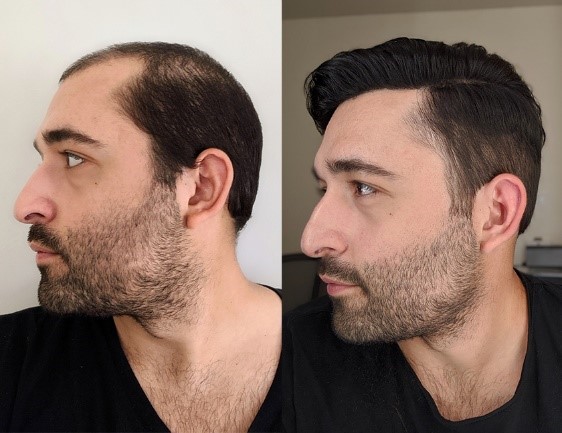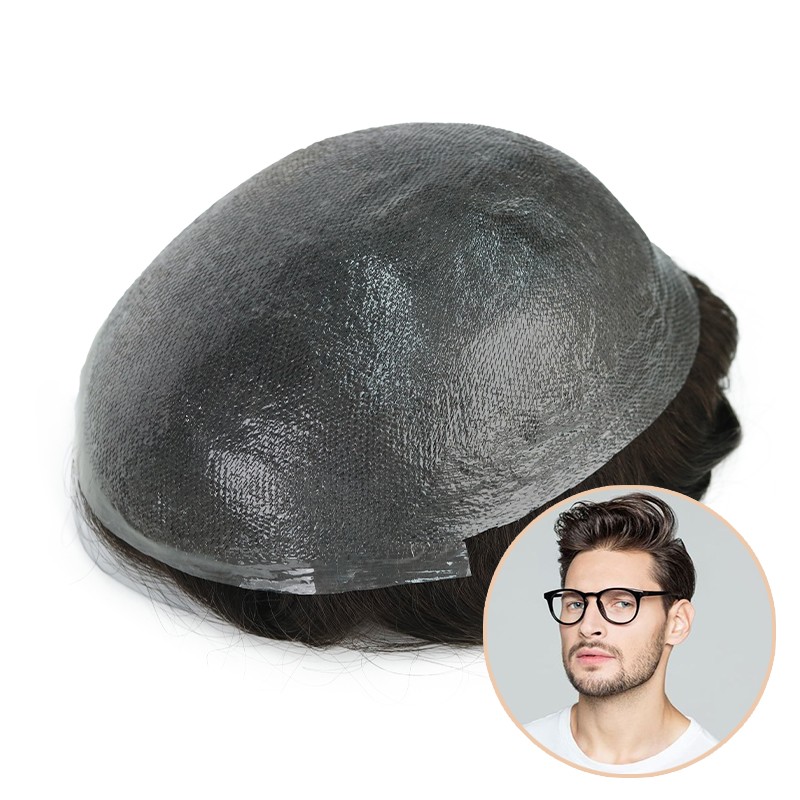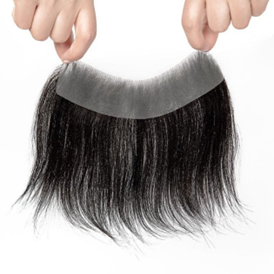Toupees for men can be a transformative solution for those experiencing hair loss or seeking to enhance their appearance. However, achieving a natural-looking toupee is crucial to maintain confidence and authenticity. In this comprehensive guide, we will explore four key steps to help men achieve a natural look with their toupees. From selecting the right toupee to styling and maintenance tips, these tips and tricks will ensure you rock a seamless and natural hairstyle. Let’s dive into the four-step process of achieving a natural-looking toupee.
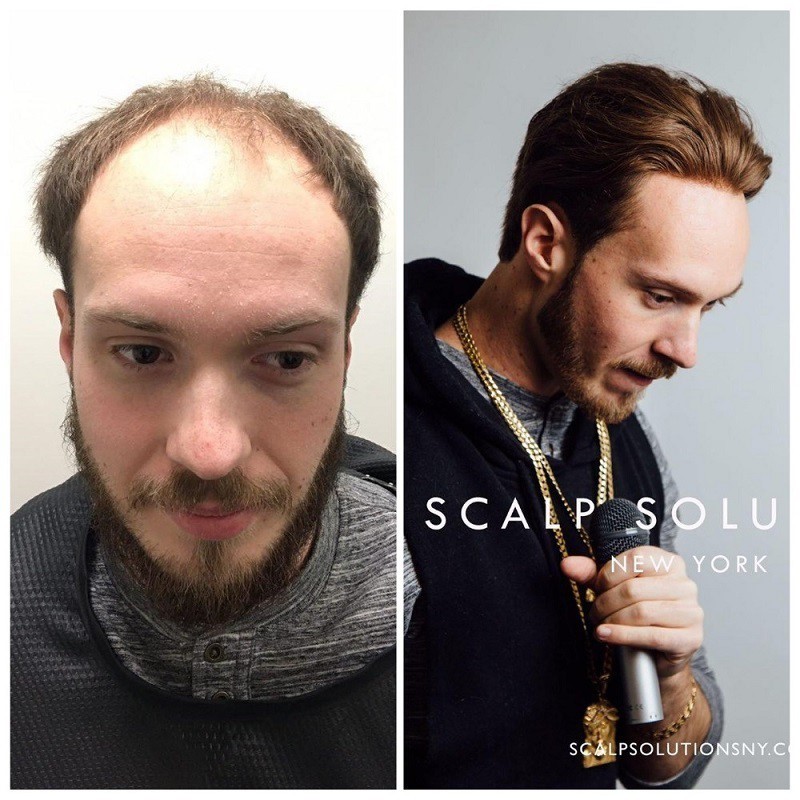
Choosing the Right Toupee
Selecting the perfect toupee is the initial and crucial step towards achieving a natural look that seamlessly blends with your existing hair. To ensure an authentic appearance, take the following factors into consideration during the toupee selection process:
- Hair Type and Color: Opt for a toupee that closely matches your natural hair type, color, and texture. This careful selection ensures a flawless blend, creating the illusion of real hair and enhancing the authenticity of your overall look.
- Base Material: When choosing a toupee, prioritize base materials that mimic the appearance of the scalp, such as lace or monofilament. These materials offer a natural-looking hairline, allowing for a seamless integration between your natural hair and the toupee. Additionally, they provide comfort and breathability during wear.
- Hair Density: Consider your natural hair density and select a toupee with a similar density. Matching the density ensures that your toupee doesn’t appear unnaturally thin or excessively thick, maintaining a natural and balanced aesthetic.
- Hairstyle and Length: Take into account your face shape, age, and personal style when selecting a toupee hairstyle and length. Whether you prefer short, medium, or long hair, choose a style that complements your features and enhances your natural appearance. This thoughtful selection will help you achieve a cohesive and harmonious overall look.
By carefully considering these factors during the toupee selection process, you can ensure a natural-looking toupee that seamlessly integrates with your existing hair, providing a confident and authentic appearance.
Proper Attachment and Blending
Properly attaching and blending your toupee is essential to achieving a natural and seamless look. Follow these expert tips for a flawless result:
- Scalp Preparation: Before attaching your toupee, it’s crucial to ensure that your scalp is clean and dry. Begin by gently cleansing your scalp with a mild shampoo, thoroughly rinsing away any residue. Once cleansed, make sure to dry your scalp completely to create an optimal attachment surface. For an even smoother surface, consider using a scalp primer or adhesive primer, which can help improve the adhesion of the toupee.
- Attachment Methods: Select an attachment method that best suits your needs and comfort level. There are various options available, including tape, adhesive, or clips. It’s important to carefully follow the manufacturer’s instructions for your chosen attachment method to ensure a secure and discreet hold. If you are unsure or want extra assurance, seeking professional assistance is highly recommended. An experienced toupee stylist can guide you through the attachment process, ensuring a secure and natural-looking result.
- Hairline Blending: One of the most critical aspects of achieving a natural look is seamlessly blending the toupee’s hairline with your natural hairline. To accomplish this, you may consider using a lace-front toupee, which features a thin, nearly invisible lace material along the hairline. This creates a realistic and natural appearance. Alternatively, if your toupee does not have a lace front, you can create a gradual hairline by using a skin-safe adhesive. Apply the adhesive along the hairline and gently press the toupee onto the scalp, ensuring a smooth transition between the toupee and your natural hair. Take your time during this process to ensure a seamless and undetectable hairline.
- Professional Styling: To achieve the best possible blend, it is highly recommended to consult with a skilled toupee stylist who has experience in creating natural-looking styles. A professional stylist can trim, shape, and style the toupee to match your natural hair and overall appearance. They have the expertise to create a cohesive and harmonious look by seamlessly blending the toupee with your existing hair. Their knowledge of toupee styling techniques and attention to detail will ensure that the toupee complements your features and enhances your overall appearance.
By following these expert tips, you can ensure a secure attachment and seamless blending of your toupee, resulting in a natural and confident look. Remember, professional guidance is invaluable in achieving the best possible outcome, so don’t hesitate to seek the assistance of a skilled toupee stylist for optimal results.
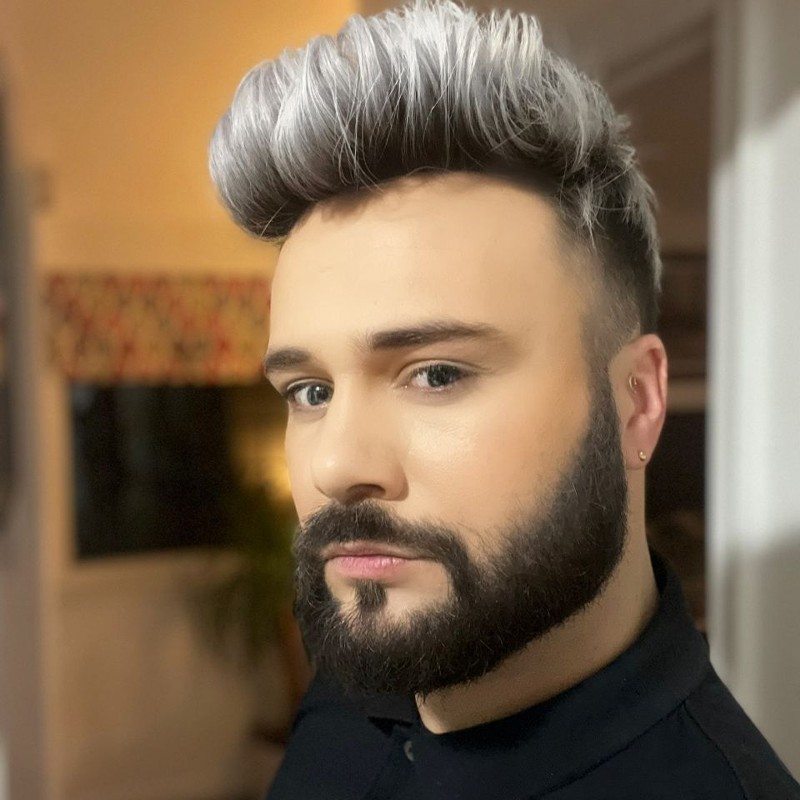
Styling Techniques for a Natural Look
Properly attaching and blending your toupee is essential to achieving a natural and seamless look. Follow these expert tips for a flawless result:
- Scalp Preparation: Before attaching your toupee, it’s crucial to ensure that your scalp is clean and dry. Begin by gently cleansing your scalp with a mild shampoo, thoroughly rinsing away any residue. Once cleansed, make sure to dry your scalp completely to create an optimal attachment surface. For an even smoother surface, consider using a scalp primer or adhesive primer, which can help improve the adhesion of the toupee.
- Attachment Methods: Select an attachment method that best suits your needs and comfort level. There are various options available, including tape, adhesive, or clips. It’s important to carefully follow the manufacturer’s instructions for your chosen attachment method to ensure a secure and discreet hold. If you are unsure or want extra assurance, seeking professional assistance is highly recommended. An experienced toupee stylist can guide you through the attachment process, ensuring a secure and natural-looking result.
- Hairline Blending: One of the most critical aspects of achieving a natural look is seamlessly blending the toupee’s hairline with your natural hairline. To accomplish this, you may consider using a lace-front toupee, which features a thin, nearly invisible lace material along the hairline. This creates a realistic and natural appearance. Alternatively, if your toupee does not have a lace front, you can create a gradual hairline by using a skin-safe adhesive. Apply the adhesive along the hairline and gently press the toupee onto the scalp, ensuring a smooth transition between the toupee and your natural hair. Take your time during this process to ensure a seamless and undetectable hairline.
- Professional Styling: To achieve the best possible blend, it is highly recommended to consult with a skilled toupee stylist who has experience in creating natural-looking styles. A professional stylist can trim, shape, and style the toupee to match your natural hair and overall appearance. They have the expertise to create a cohesive and harmonious look by seamlessly blending the toupee with your existing hair. Their knowledge of toupee styling techniques and attention to detail will ensure that the toupee complements your features and enhances your overall appearance.
By following these expert tips, you can ensure a secure attachment and seamless blending of your toupee, resulting in a natural and confident look. Remember, professional guidance is invaluable in achieving the best possible outcome, so don’t hesitate to seek the assistance of a skilled toupee stylist for optimal results.
Maintenance and Care for a Natural Look
Proper maintenance and care are paramount in preserving the natural look and longevity of your toupee. Follow these essential tips to keep your toupee in optimal condition:
- Regular Cleaning: Cleanse your toupee regularly using gentle shampoos and conditioners specifically formulated for toupees. Harsh products or hot water can damage the hair fibers, so it’s important to choose products designed for delicate hairpieces. Fill a basin with lukewarm water and add a small amount of shampoo. Gently swirl the toupee in the water, avoiding rubbing or agitating the hair. Rinse thoroughly to remove all the shampoo. Follow up with a quality conditioner, focusing on the ends of the hair. Leave the conditioner on for a few minutes before rinsing again. Pat the toupee dry with a soft towel, being careful not to rub or wring the hair.
- Gentle Brushing: To prevent tangling or matting, use a wide-toothed comb or a specialized toupee brush to gently detangle the hair. Start from the ends of the hair, working your way up to the roots. Be gentle and avoid using excessive force, as rough brushing can cause hair breakage or damage to the toupee. Take your time and be patient when detangling to ensure the hair remains in optimal condition.
- Storage and Protection: Proper storage is essential to maintain the shape and quality of your toupee. When not wearing your toupee, store it on a wig stand or in a breathable fabric bag. This helps the toupee retain its shape and protects it from dust or damage. Avoid storing the toupee in direct sunlight or near heat sources, as excessive heat can cause the hair fibers to become brittle and lose their color. Additionally, consider using a specialized toupee storage box for added protection during travel or extended periods of non-use.
- Regular Maintenance: Schedule regular maintenance appointments with a toupee stylist or barber who specializes in toupee care. These professionals can assess the condition of your toupee, make any necessary adjustments or repairs, and provide guidance on proper care techniques. Regular maintenance ensures that your toupee remains in optimal condition, allowing you to maintain its natural look and extend its lifespan. During these appointments, the stylist can also provide valuable tips and advice on how to best care for your toupee between visits.
By following these maintenance and care tips, you can keep your toupee looking its best and maintain its natural appearance. Regular cleaning, gentle brushing, proper storage, and regular maintenance appointments with a professional will help preserve the integrity and longevity of your toupee, ensuring that it continues to enhance your appearance with a natural and seamless look.

Hair System Starter Kit for both Skin and Lace Hair Systems | Prof Hair Lab
Conclusion
Achieving a natural look with your toupee is within reach by following these four essential steps. From choosing the right toupee to proper attachment, styling techniques, and maintenance, you can rock a seamless and authentic hairstyle. Remember, a natural-looking toupee boosts your confidence and allows you to present your best self to the world. Embrace these tips and tricks, consult with professionals when needed, and enjoy your journey of achieving a natural look with your toupee. To learn more, click on https://www.lavividhair.com


